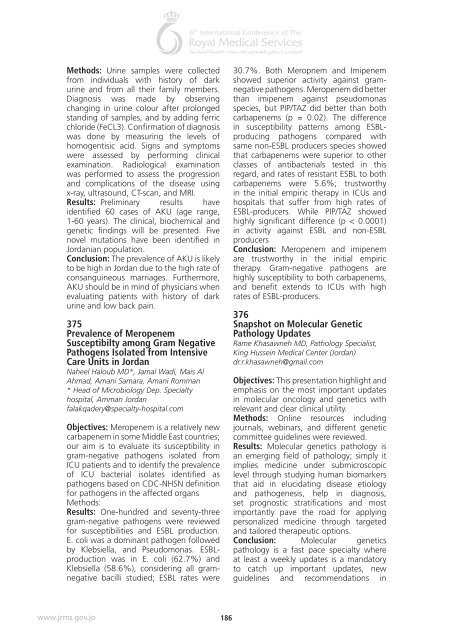Abstract book 6th RMS 16.indd
Abstract book 6th RMS 16.indd
Abstract book 6th RMS 16.indd
You also want an ePaper? Increase the reach of your titles
YUMPU automatically turns print PDFs into web optimized ePapers that Google loves.
Methods: Urine samples were collected<br />
from individuals with history of dark<br />
urine and from all their family members.<br />
Diagnosis was made by observing<br />
changing in urine colour after prolonged<br />
standing of samples, and by adding ferric<br />
chloride (FeCL3). Confirmation of diagnosis<br />
was done by measuring the levels of<br />
homogentisic acid. Signs and symptoms<br />
were assessed by performing clinical<br />
examination. Radiological examination<br />
was performed to assess the progression<br />
and complications of the disease using<br />
x-ray, ultrasound, CT-scan, and MRI.<br />
Results: Preliminary results have<br />
identified 60 cases of AKU (age range,<br />
1-60 years). The clinical, biochemical and<br />
genetic findings will be presented. Five<br />
novel mutations have been identified in<br />
Jordanian population.<br />
Conclusion: The prevalence of AKU is likely<br />
to be high in Jordan due to the high rate of<br />
consanguineous marriages. Furthermore,<br />
AKU should be in mind of physicians when<br />
evaluating patients with history of dark<br />
urine and low back pain.<br />
375<br />
Prevalence of Meropenem<br />
Susceptibilty among Gram Negative<br />
Pathogens Isolated from Intensive<br />
Care Units in Jordan<br />
Naheel Haloub MD*, Jamal Wadi, Mais Al<br />
Ahmad, Amani Samara, Amani Romman<br />
* Head of Microbiology Dep. Specialty<br />
hospital, Amman Jordan<br />
falakqadery@specialty-hospital.com<br />
Objectives: Meropenem is a relatively new<br />
carbapenem in some Middle East countries;<br />
our aim is to evaluate its susceptibility in<br />
gram-negative pathogens isolated from<br />
ICU patients and to identify the prevalence<br />
of ICU bacterial isolates identified as<br />
pathogens based on CDC-NHSN definition<br />
for pathogens in the affected organs<br />
Methods:<br />
Results: One-hundred and seventy-three<br />
gram-negative pathogens were reviewed<br />
for susceptibilities and ESBL production.<br />
E. coli was a dominant pathogen followed<br />
by Klebsiella, and Pseudomonas. ESBLproduction<br />
was in E. coli (62.7%) and<br />
Klebsiella (58.6%), considering all gramnegative<br />
bacilli studied; ESBL rates were<br />
30.7%. Both Meropnem and Imipenem<br />
showed superior activity against gramnegative<br />
pathogens. Meropenem did better<br />
than imipenem against pseudomonas<br />
species, but PIP/TAZ did better than both<br />
carbapenems (p = 0.02). The difference<br />
in susceptibility patterns among ESBLproducing<br />
pathogens compared with<br />
same non-ESBL producers species showed<br />
that carbapenems were superior to other<br />
classes of antibacterials tested in this<br />
regard, and rates of resistant ESBL to both<br />
carbapenems were 5.6%; trustworthy<br />
in the initial empiric therapy in ICUs and<br />
hospitals that suffer from high rates of<br />
ESBL-producers. While PIP/TAZ showed<br />
highly significant difference (p < 0.0001)<br />
in activity against ESBL and non-ESBL<br />
producers<br />
Conclusion: Meropenem and imipenem<br />
are trustworthy in the initial empiric<br />
therapy. Gram-negative pathogens are<br />
highly susceptibility to both carbapenems,<br />
and benefit extends to ICUs with high<br />
rates of ESBL-producers.<br />
376<br />
Snapshot on Molecular Genetic<br />
Pathology Updates<br />
Rame Khasawneh MD, Pathology Specialist,<br />
King Hussein Medical Center (Jordan)<br />
dr.r.khasawneh@gmail.com<br />
Objectives: This presentation highlight and<br />
emphasis on the most important updates<br />
in molecular oncology and genetics with<br />
relevant and clear clinical utility.<br />
Methods: Online resources including<br />
journals, webinars, and different genetic<br />
committee guidelines were reviewed.<br />
Results: Molecular genetics pathology is<br />
an emerging field of pathology; simply it<br />
implies medicine under submicroscopic<br />
level through studying human biomarkers<br />
that aid in elucidating disease etiology<br />
and pathogenesis, help in diagnosis,<br />
set prognostic stratifications and most<br />
importantly pave the road for applying<br />
personalized medicine through targeted<br />
and tailored therapeutic options.<br />
Conclusion: Molecular genetics<br />
pathology is a fast pace specialty where<br />
at least a weekly updates is a mandatory<br />
to catch up important updates, new<br />
guidelines and recommendations in<br />
www.jrms.gov.jo<br />
186

















